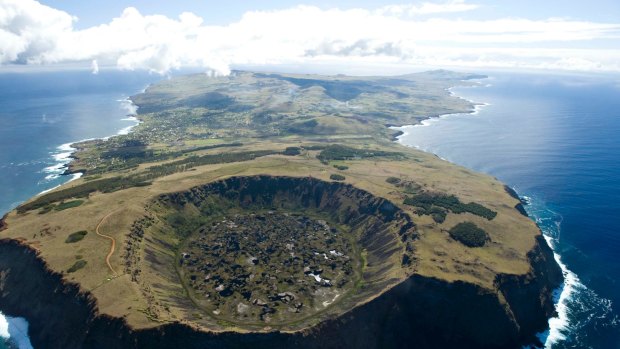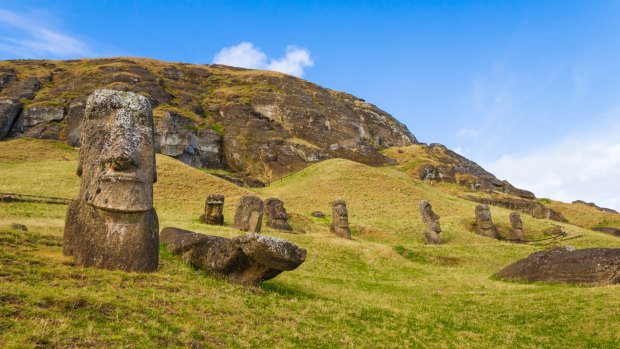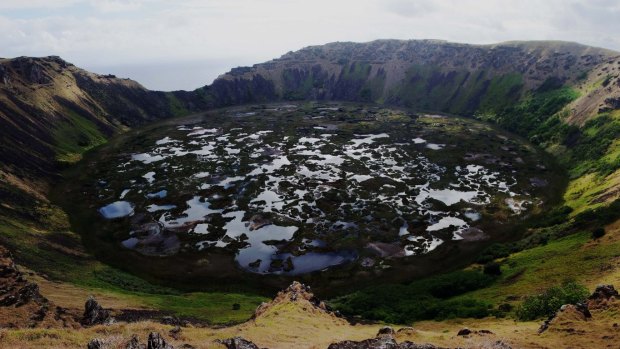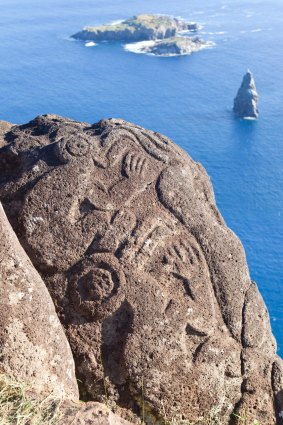This was published 7 years ago
Easter Island: The island at the end of the Earth
By Isobel King

Easter Island's staple industry is tourism, which pulls in about 90,000 visitors a year.
For Australians, Easter Island may well seem a long way to travel for a small Polynesian island bereft of palm trees and luscious stretches of white, powdery beaches, its iconic stone statues so instantly recognisable that it dwarfs all other attractions.
After all, this is the most isolated permanently inhabited place on earth, a speck of volcanic mounds in a vast ocean. To put its 163 square kilometres into perspective, a marathon runner recently sweated his way around the entire island in just one day, our guide assures us.
The nearest island is Pitcairn, almost 2000 kilometres away, and the only entry point for tourists is via Chile – which Easter Island belongs to – or Tahiti, both around five hours' flight away. Cruise liners occasionally swing by, but the waters are often too rough for passengers to land.

Around 95 per cent of the island's known monolithic sculptures (moai) were carved from stone quarried from Rano Raraku, a volcanic crater formed of consolidated volcanic ash, or tuff, located in the Rapa Nui National Park.Credit: iStock
Yet it's this stark isolation that fuels the mystique of Easter Island, also known by its indigenous name, Rapa Nui, and Spanish name, Isla de Pascua (useful information when you're trying to locate your departure flight in Santiago).
Today, tourism is the island's staple industry, pulling in around 90,000 visitors a year, nearly a quarter of those cramming the hiking paths, small township and main tourist attractions in the peak season of January/February, reaching a crescendo during the 10-day Tapati cultural festival. Yet it was the feverish building of colossal stone statues, the moai, that occupied the early settlers of Rapa Nui, and it's these mysterious monoliths that draw in the crowds.
A great starting point for any curious visitor is the little one-room archaeological museum in the island's only township of Hanga Roa, where most of the population of 8000 live. It answers my burning question of how on earth a band of Polynesian seafarers in canoes even stumbled upon an island so remote, yet alone went on to inhabit it.

Crater Volcano Rano Kau in Easter Island.
It turns out they were extraordinary navigators, using the stars primarily, but also marine currents, wind directions and the travel routes of nesting birds to locate new islands. There's sketches of the high-sea canoes it's believed they used to reach Rapa Nui and later colonise it somewhere between 800 and 1200AD – around the same time these seafaring Polynesians were populating New Zealand (800 to 1000AD).
That certainly accounts for the amazing cultural similarities to the maori haka we witnessed when we were placed front row at a traditional show in town. For our delicate, jet-lagged troupe, it was a visceral onslaught – stomping, victorious roars, and men in loin cloths and tribal paint, thrusting batons wide-eyed in front of us.
The museum, of course, also has lots of background on the moai, built by a highly spiritual people to salute their ancestors. Of the 887 known moai, nearly all carved from volcanic rock at the Rano Raraku quarry in the island's south-east, nearly half remain in the quarry in various stages of completion; 288 were successfully transported and erected on the familiar Ahu stone altars located at coastal spots around the island. The largest one ever erected, called Paro, is nearly 10 metres high and weighs in at a hefty 74 tonnes. But El Gigante, which is still attached to bedrock in the quarry, takes top honours, at 21.6 metres high and an estimated 170 tonnes.

Carved boulder. Credit: iStock
The statue building came to an abrupt end around the 17th century, when tribal war broke out, most likely sparked by environmental carnage and dwindling resources. By the time the first Europeans arrived in 1722, the forests of palm trees were gone, exposing the volcanic soil to erosion and creating the barren landscape you see today.
It's late April when we visit Rapa Nui: autumn, and the crowds have gone, the hiking trails are blissfully empty and it's balmy T-shirt weather. Who'd be bothered with high season, I ask myself? At Explora, one of the island's handful of luxury lodgings, our guide for the four days is trained psychologist Carolina, whose infectious exuberance and detailed knowledge of Easter Island is a product of both her own natural curiosity and Explora's strict screening and training of their guides, who often rotate between sister Explora properties in Chile's Atacama Desert (temporarily closed due to a fire) and Patagonia. It's three months of intensive learning and tests, so there's no question you can fire at Carolina that doesn't return a decisive, detailed and colourful explanation.
The hotel is among rare farming land, about 10 minutes' drive from town, with all 30 rooms enjoying elevated views of the coastline. However, the emphasis – like all Explora properties – is on getting you out and about, so every evening guests gather to choose their outing for the following day.
There's a choice of half-day or full-day excursions. By the time you leave, you will almost definitely have done the compulsory trip to Rano Raraku quarry and nearby Fifteen Moai at Ahu Tongariki. There's a half-day hike to the highest point on the island, with spectacular 360-degree views; and a trip to the underground caves where many of the tribes once lived, which takes in petroglyphs, offering a fascinating insight into how the early Rapa Nui lived.
The highlight for me was the 10km half-day hike to the crater lake of Rano Kau on a crystal clear morning, the walk hugging the cliffs up a fairly steady incline that tested the stamina of us mostly middle-aged crew of varying fitness levels. After navigating a rock-strewn path for a couple of hours, I certainly appreciated why walking sticks are handed out so liberally and spares carried by the guides. They're a godsend for the knees.
Hiking the windswept fringes only seemed to reinforce a liberating sense of isolation. A blindingly blue sea thunders against craggy cliffs that butt up against vibrant red volcanic earth, much of it exposed by persistent erosion. Scrubland best sums up the rest.
Suddenly Carolina halts us in our tracks. "Close your eyes, hang onto the person in front and follow me." We gingerly follow orders and stumble forwards. "Okay, open your eyes!" Here, on the edge of the cliffs, we're peering down into the one-kilometre-wide Rano Kau crater lake. Windex-blue patches of water pierce through giant clumps of floating plants. It's utterly spectacular. After the frenzy of camera-clicking ceases, we pause to hear how the tradition of the Birdman was born here after the statue building ceased; the dawn of a new social order. The short version is that a nominated member of each of the island's tribes would swim out to the islet just offshore each September, when the seabirds migrated here, and whoever secured the first egg would secure his tribal leader ruling rights for the next year.
This islet takes on even greater significance when Carolina assures us there's visibility of up to 50 metres if you want to snorkel around the rocky outcrop. As an avid lap swimmer, I immediately picture the length of an Olympic-sized swimming pool and imagine staring that far into azure blue with perfect visibility.
The expedition concludes with a visit to nearby Orongo, on the lip of the crater, the ceremonial village used by the Rapa Nui people during the Birdman era.
Today, it's a collection of weathered stone houses and petroglyphs set on a brutally exposed clifftop. A snippet at the information centre brings home the fragility of not just these structures, but all the island's moai and rock carvings. "In a period of just 97 years, extreme weather has caused deterioration of the petroglyphs … details have disappeared: edgings of the engravings, the borders of every detail … thus we have a clear idea of the damage caused by natural factors."
It doesn't augur well for the moai, their features already severely blunted by the elements, clawing lichen and their precarious coastal locations. I feel privileged to have walked among giants that one day will inevitably be reclaimed by nature.
TRIP NOTES
LAN Airlines operates daily flights between Sydney and Santiago via Auckland. There are flights to Easter Island from Santiago every day except Tuesday. Australian citizens pay a reciprocity fee of US$117 on arrival in Santiago. latam.com.
STAY
The Explora Hotel Posada de Mike Rapu Easter Island is an all-inclusive, 30-room hotel (all meals and beverages and daily excursions with bilingual guides are included). Curved, glass-fronted pavilions housing the bar, restaurant and lounging areas offer panoramic ocean views. There's also a massage room, outdoor pool and spa. Three-night packages from $2538 a person, twin-share. See explora.com.
GET AROUND
There is no public transport on Easter Island, probably because nearly everyone lives in town. There's a sealed road around much of the island and rougher roads lead to less accessible areas. Explora includes free transport to attractions. However, for those who want their own wheels, the hotel has bicycles. Otherwise, there's a fleet of rental places on the main street of Hanga Roa. Prices aren't cheap. You can rent a scooter for about 25,000CLP a day (motorcycle licence required); cars start from around 45,000CLP.
Isobel King travelled courtesy of South America Tourism Office and LATAM Airlines.
Sign up for the Traveller Deals newsletter
Get exclusive travel deals delivered straight to your inbox. Sign up now.